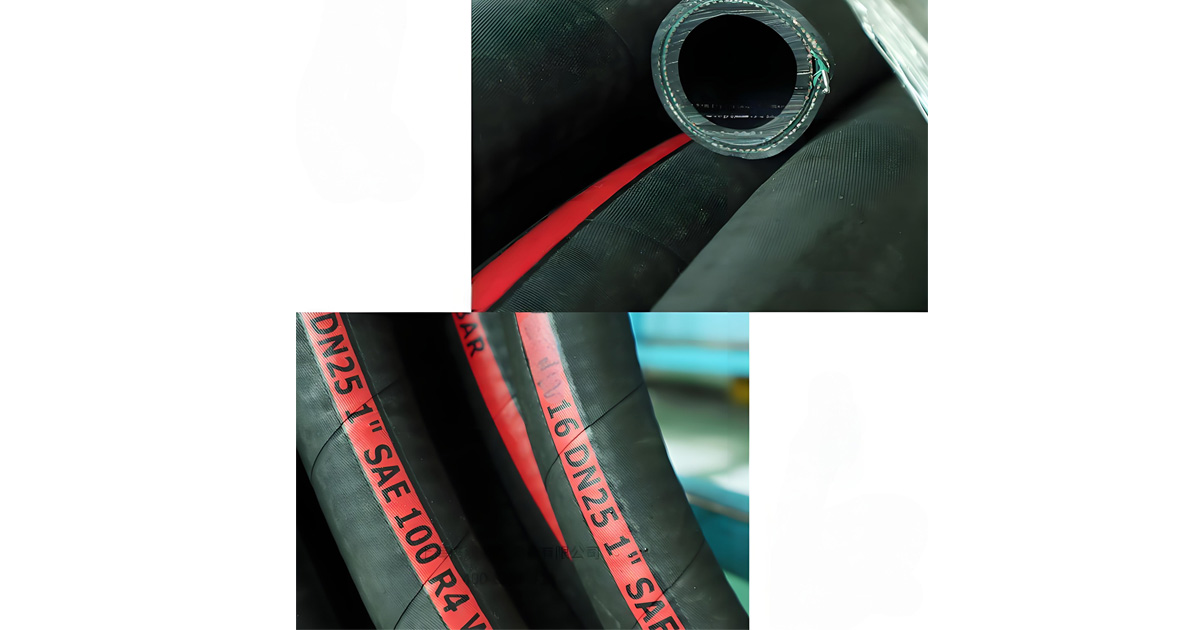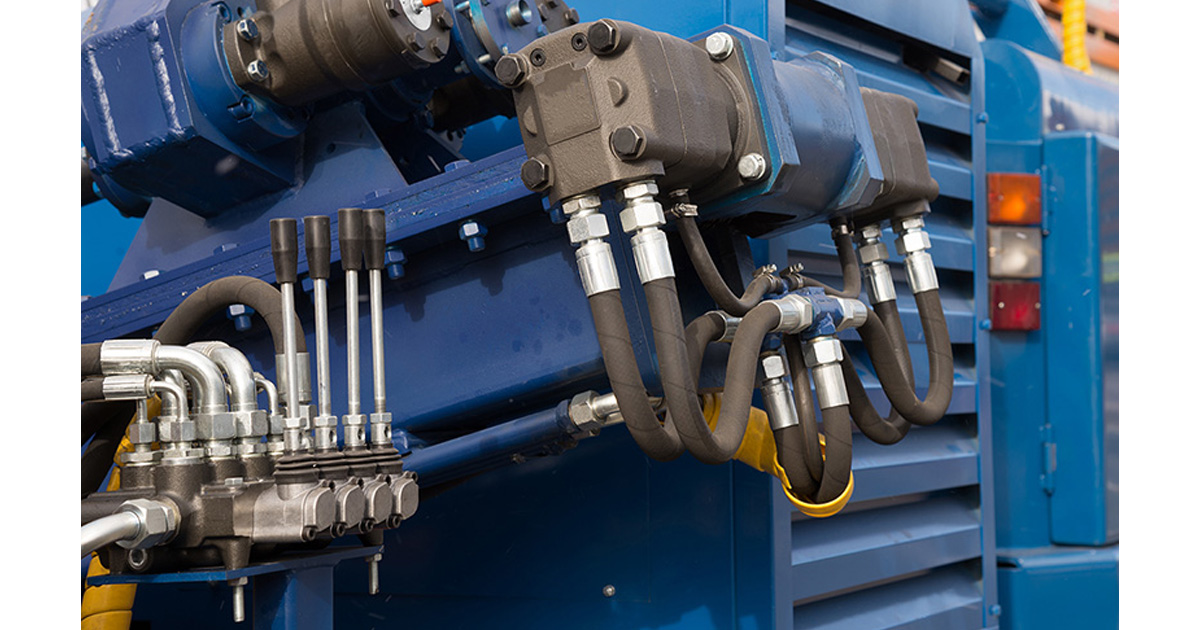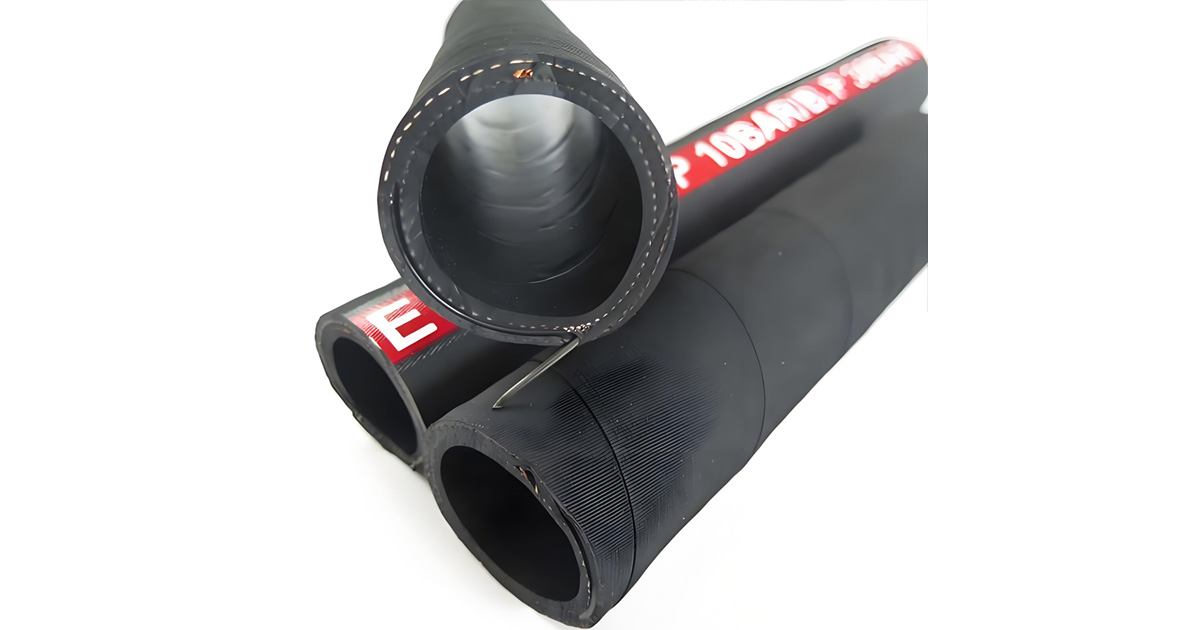हाइड्रोलिक प्रणाली में, कार्यशील द्रव की वापसी शायद ही कभी उसी पथ पर होती है जिस पर वह दबाव पड़ने पर होती है (जैसे कि एक साधारण हाइड्रोलिक जैक में)। आमतौर पर, द्रव को एक लाइन से पंप किया जाता है, अपना कार्य पूरा करता है, और फिर एक अलग लाइन के माध्यम से जलाशय में वापस प्रवाहित होता है। चूषण और वापसी नलीयहीं पर हाइड्रोलिक रिटर्न होज़ काम में आते हैं।

वापसी नली रबर से बने होते हैं, जिन्हें भी कहा जाता है हाइड्रोलिक तेल वापसी नली.रिटर्न होज़ हैं सामान्य हाइड्रोलिक होज़ की तुलना में कम दबाव, और उन्हें तेल प्रतिरोधी होना चाहिए ताकि वे विभिन्न प्रकार के हाइड्रोलिक तरल पदार्थों और तेल-आधारित माध्यमों का परिवहन कर सकें। उनकी सुदृढ़ीकरण परत स्टील वायर सुदृढ़ीकरण के बजाय टेक्सटाइल ब्रैड्स या फैब्रिक परतें हैं, और उन्हें अधिक लचीला और मजबूत बनाने के लिए उन्हें हेलिकल स्टील वायर के साथ जोड़ा जाता है।
सही सक्शन और रिटर्न होज़ का चयन हाइड्रोलिक सिस्टम के लिए महत्वपूर्ण है। ये होज़ हाइड्रोलिक घटकों के बीच द्रव का स्थानांतरण करते हैं। इस गाइड में, हम हाइड्रोलिक सक्शन और रिटर्न होज़ क्या हैं, उनके कार्य क्या हैं और उन्हें कैसे चुनें, इस पर चर्चा करेंगे।
हाइड्रोलिक सक्शन नली क्या है?
एक सक्शन लाइन हाइड्रोलिक जलाशय को पंप से जोड़ती है, जिससे द्रव पंप में सुचारू रूप से प्रवाहित होता रहता है। इसका मुख्य कार्य कम दबाव पर हाइड्रोलिक तेल की निरंतर आपूर्ति सुनिश्चित करना है, जिससे पंप को नुकसान पहुँचाने वाली रुकावटों को रोका जा सके।
सक्शन नली के लिए मुख्य विचार
सक्शन होज़ सिंथेटिक रबर या थर्मोप्लास्टिक सामग्री से बने होते हैं। इनका उपयोग मुख्यतः हाइड्रोलिक वैक्यूम अनुप्रयोगों में किया जाता है। ये होज़ लचीली और टिकाऊ होती हैं। इसलिए जब पंप सक्शन के तहत तरल पदार्थ खींचता है, तो ये टूटने से बचा सकती हैं।
सक्शन नली का आंतरिक व्यास बेहतर काम करने के लिए पर्याप्त बड़ा होना चाहिए। अगर रिटर्न नली का आईडी बहुत छोटा है, तो यह प्रवाह को बाधित करेगा, जिससे पंप में रुकावट, गुहिकायन और समय से पहले पंप की विफलता हो सकती है।
आपको यह सुनिश्चित करना चाहिए कि रिटर्न होज़ की सामग्री हाइड्रोलिक द्रव के अनुकूल हो। अगर यह अनुकूल न हो, तो होज़ फूल जाएगी, खराब हो जाएगी, कार्यक्षमता कम हो जाएगी और हाइड्रोलिक सिस्टम टूट जाएगा।
सक्शन होज़ में हाइड्रोलिक सिस्टम के तापमान और वैक्यूम स्तरों की विस्तृत रेंज होनी चाहिए। स्थापना से पहले, आपको कार्य स्थितियों में विश्वसनीय प्रदर्शन सुनिश्चित करने के लिए होज़ की निर्धारित तापमान और दबाव क्षमता सुनिश्चित करनी चाहिए।
हाइड्रोलिक रिटर्न नली क्या है?
रिटर्न नली हाइड्रोलिक प्रणाली घटकों से हाइड्रोलिक द्रव को वापस जलाशय में स्थानांतरित करती है। यह मानक हाइड्रोलिक नली से अलग है, रिटर्न नली कम दबाव में काम करती है, लेकिन इसमें उच्च प्रवाह दर होनी चाहिए।
रिटर्न होज़ के लिए मुख्य विचार
रिटर्न होज़ का आकार इतना बड़ा होना चाहिए कि वह उच्च द्रव मात्रा से उत्पन्न अत्यधिक दबाव को संभाल सके। पर्याप्त आंतरिक व्यास वाली होज़ चुनने से सुचारू प्रवाह सुनिश्चित होता है और सिस्टम कुशलतापूर्वक काम करता है, खासकर अधिकतम प्रवाह स्थितियों के दौरान।
रिटर्न होज़, मानक हाइड्रोलिक होज़ की तुलना में कम दबाव झेल सकते हैं। लेकिन इन्हें हाइड्रोलिक सिस्टम के अनुसार भी काम करना चाहिए, क्योंकि हाइड्रोलिक सिस्टम में दबाव में उतार-चढ़ाव या उतार-चढ़ाव आसानी से हो सकता है।
रिटर्न होज़ हमेशा चुनौतीपूर्ण पर्यावरणीय परिस्थितियों के संपर्क में रहते हैं। घर्षण-प्रतिरोधी कवर और मौसम-प्रतिरोधी होज़ चुनने से दीर्घकालिक स्थायित्व और कम रखरखाव की आवश्यकता सुनिश्चित हो सकती है।
सक्शन और रिटर्न होसेस के बीच मुख्य अंतर
सक्शन लाइनों का उपयोग वैक्यूम और कम दबाव वाले अनुप्रयोगों में किया जाता है, यदि आप कम गुणवत्ता वाली नली चुनते हैं, या इसे इसके निर्धारित दबाव सीमा से परे उपयोग करते हैं, तो नली टूट सकती है।
रिटर्न लाइनों का उपयोग कम दबाव वाले वातावरण में भी किया जाता है, लेकिन उन्हें बड़े प्रवाह दर की आवश्यकता होती है और वे तेल प्रतिरोधी होती हैं।
दोनों होज़ों को टेक्सटाइल ब्रैड से मजबूत किया गया है, लेकिन तेल चूषण पाइप को टूटने से बचाने के लिए हेलिकल वायर से भी मजबूत किया गया है
| लक्षण | सक्शन नली | वापसी नली |
| समारोह | जलाशय को पंप से जोड़ता है; पंप इनलेट को तेल की आपूर्ति करता है | सिस्टम संचालन के बाद तेल को वापस भंडार में ले जाता है |
| परिचालन दाब | निर्वात/कम दबाव में संचालित होता है | कम दबाव में संचालित होता है लेकिन उछाल को संभालना पड़ता है |
| प्रवाह विशेषताएँ | चूषण के तहत पतन को रोकना चाहिए | बिना किसी दबाव के उच्च प्रवाह दर को संभालना आवश्यक है |
| सुदृढीकरण संरचना | अक्सर कुंडलित तार + कपड़ा परतों से प्रबलित | आमतौर पर कपड़ा लट या कपड़े की परतें; कभी-कभी हल्के तार हेलिक्स |
| प्रमुख जोखिम | गुहिकायन, पंप भुखमरी, नली का टूटना, हवा का प्रवेश | अत्यधिक बैक प्रेशर, रिसाव, घर्षण क्षति |
| सामग्री की आवश्यकताएं | तेल प्रतिरोधी, वैक्यूम प्रतिरोधी, लचीली सामग्री | तेल प्रतिरोधी, घर्षण प्रतिरोधी, मौसम प्रतिरोधी कवर |
| विशिष्ट डिज़ाइन संबंधी विचार | दबाव में कमी को न्यूनतम करने के लिए बड़ी आईडी; वैक्यूम का सामना करने में सक्षम | अधिकतम प्रवाह क्षमता के लिए आकार; निस्पंदन अनुशंसित |
हाइड्रोलिक सक्शन और रिटर्न होसेस के कार्य
हाइड्रोलिक सिस्टम में, तेल टैंक से हाइड्रोलिक सिलेंडर जैसे एक्चुएटर्स तक काम करने के लिए जाता है। उसके बाद, तेल को वापस टैंक में जाना होता है। इस तरह, पंप और अन्य पुर्जे चलते रहते हैं। एक्स्कवेटर जैसी मशीनों में, रिटर्न लाइन का मुख्य काम तेल को वापस टैंक में भेजना होता है। इससे तेल चलता रहता है और सिस्टम काम करता रहता है।
2. दबाव संतुलन
रिटर्न लाइन दबाव को स्थिर रखने में भी मदद करती है। जब एक्ट्यूएटर काम करते हैं, तो तेल अलग-अलग दबाव स्तरों का सामना करता है। सिस्टम को सुरक्षित और स्थिर रखने के लिए, इन दबावों का समान होना ज़रूरी है। रिटर्न लाइन अतिरिक्त दबाव को दूर करती है और सिस्टम को संतुलित रखती है। इससे सिस्टम सुचारू और भरोसेमंद तरीके से चलता है।
3. ऊष्मा अपव्यय
सिस्टम के चलने पर तेल गर्म हो जाता है। अगर तेल ज़्यादा गर्म हो जाए, तो सिस्टम की कार्यक्षमता कम हो जाती है और उसके पुर्जे जल्दी खराब हो जाते हैं। तेल को वापस टैंक में पहुँचाकर, रिटर्न लाइन ठंडा करने में मदद करती है। तेल या तो टैंक में ही ठंडा होता है या कूलर के ज़रिए। इससे तापमान सही स्तर पर बना रहता है।

सही हाइड्रोलिक सक्शन और रिटर्न होज़ का निर्धारण कैसे करें
सर्वोत्तम सक्शन और रिटर्न होज़ चुनने के लिए सिस्टम आवश्यकताओं, होज़ विनिर्देशों और परिचालन स्थितियों के बीच संतुलन बनाना आवश्यक है। यहाँ चरण-दर-चरण मार्गदर्शिका दी गई है:
सक्शन और रिटर्न होज़ चुनते समय, सबसे पहले यह जाँच लें कि सिस्टम को क्या चाहिए। कार्यशील दबाव और तापमान देखें। सक्शन लाइन और रिटर्न लाइन में अधिकतम प्रवाह मापें। पर्यावरण के बारे में भी सोचें। होज़ को गर्मी, ठंड, घर्षण या रसायनों का सामना करना पड़ सकता है।
इसके बाद, सही नली का आकार चुनें। आंतरिक व्यास का प्रवाह और दबाव के साथ मिलान करें। सक्शन लाइनों में, कैविटेशन से बचने के लिए दबाव में गिरावट कम रखें। वापसी लाइनों में, सुनिश्चित करें कि नली बिना किसी दबाव के अधिकतम प्रवाह को संभाल सके।
नली की सामग्री तरल पदार्थ से मेल खानी चाहिए। आपको पेट्रोलियम तेल, सिंथेटिक तेल या बायोडिग्रेडेबल तेल के लिए उपयोग की जाने वाली नली का उपयोग करना चाहिए।
SAE या ISO मानक आपके सक्शन और रिटर्न होज़ के लिए बुनियादी मानक है। यह सिस्टम को सुरक्षित और विश्वसनीय बनाता है।
नली लगाते समय, रिसाव रोकने के लिए अच्छी फिटिंग और कनेक्टर का इस्तेमाल करें। नली को क्लैंप या ब्रैकेट से ठीक करें ताकि वह हिले या रगड़े नहीं।
| कदम | प्रमुख बिंदु |
| सिस्टम आवश्यकताओं को समझें | - कार्य दबाव और तापमान की पहचान करें - चूषण और वापसी लाइनों में अधिकतम प्रवाह दर को मापें - पर्यावरणीय कारकों (गर्मी, ठंड, रसायन) का मूल्यांकन करें |
| सही नली का आकार चुनें | - प्रवाह दर और दबाव का मिलान करने के लिए नली आईडी चार्ट का उपयोग करें - सक्शन लाइनों के लिए: कैविटेशन को रोकने के लिए दबाव में गिरावट को न्यूनतम करें - वापसी लाइनों के लिए: बिना दबाव के अधिकतम प्रवाह की क्षमता सुनिश्चित करें |
| अनुकूलता पर ध्यान दें | - हाइड्रोलिक द्रव के साथ नली सामग्री की संगतता सत्यापित करें - पेट्रोलियम-आधारित, सिंथेटिक या बायोडिग्रेडेबल तेलों के लिए होज़ का चयन करें |
| प्रमाणपत्रों और मानकों की जाँच करें | - सुनिश्चित करें कि होज़ SAE या ISO मानकों का अनुपालन करते हैं - विश्वसनीयता और सुरक्षा प्रमाणित होज़ पर निर्भर करती है |
| नली संयोजन आवश्यकताओं पर विचार करें | - रिसाव को कम करने के लिए उच्च गुणवत्ता वाली फिटिंग/कनेक्टर का उपयोग करें - कंपन और घिसाव को कम करने के लिए क्लैंप/ब्रैकेट से होज़ को सुरक्षित करें |
सक्शन और रिटर्न होज़ चुनते समय बचने वाली सामान्य गलतियाँ
बहुत छोटी होज़ का इस्तेमाल समस्याएँ पैदा कर सकता है। अगर होज़ रिटर्न लाइन है, तो प्रवाह बाधित होता है और इससे बैकप्रेशर बनता है। बहुत ज़्यादा बैकप्रेशर अपस्ट्रीम प्रेशर को कम कर देता है। इससे ओवरहीटिंग, कम दक्षता और यहाँ तक कि पुर्जों को नुकसान भी हो सकता है।
यदि नली एक सक्शन लाइन है, तो उसका छोटा आकार पंप इनलेट पर प्रवाह को बाधित करता है। इससे नकारात्मक दबाव या वैक्यूम बन सकता है। इससे पंप में गुहिकायन हो सकता है। गुहिकायन पंप को नुकसान पहुँचा सकता है, सिस्टम के प्रदर्शन को कम कर सकता है, और सिस्टम के दबाव को कम कर सकता है।
प्रेशर रेटिंग की जाँच न करना भी एक जोखिम है। सक्शन और रिटर्न होज़ सप्लाई होज़ की तुलना में कम दबाव पर काम करते हैं, लेकिन अगर आप उनकी सीमा से ऊपर जाते हैं, तो वे खराब हो सकते हैं या फट भी सकते हैं।
एक और गलती फ़िल्टरों की अनदेखी करना है। अगर आप रिटर्न-लाइन फ़िल्टर नहीं लगाते हैं, तो गंदगी और अन्य दूषित पदार्थ सिस्टम में घूमते रहते हैं। इससे पुर्जे जल्दी घिस जाते हैं और हाइड्रोलिक सिस्टम की उम्र कम हो जाती है।
हाइड्रोलिक सक्शन और रिटर्न होसेस के सामान्य अनुप्रयोग
हाइड्रोलिक होज़ का उपयोग हाइड्रोलिक प्रणालियों में तरल पदार्थ स्थानांतरित करने के लिए किया जाता है। हाइड्रोलिक प्रणाली के संचालन और उसके जीवनकाल के लिए सही होज़ का चयन करना महत्वपूर्ण है। यहाँ सक्शन और रिटर्न होज़ के कुछ उपयोग दिए गए हैं जिनका उपयोग तरल पदार्थ और सिस्टम प्रकारों में किया जा सकता है।
जल-आधारित हाइड्रोलिक तरल पदार्थों का उपयोग अक्सर अग्निरोधी अनुप्रयोगों में किया जाता है, जैसे खनन या औद्योगिक क्षेत्र में। होज़ों को जल अवशोषण का प्रतिरोध करना चाहिए और कम तापमान में लचीला होना चाहिए।
तापीय द्रव तापन प्रणालियों में, होज़ बहुत गर्म द्रव ले जाते हैं। उन्हें अपनी कार्यक्षमता खोए बिना अत्यधिक गर्मी को संभालना होता है। इनका उपयोग अक्सर औद्योगिक तापन या प्लास्टिक मोल्डिंग उपकरण जैसी मशीनों में किया जाता है।
पेट्रोलियम-आधारित तरल पदार्थों के लिए, होज़ों को तेल और हाइड्रोकार्बन का प्रतिरोध करने की आवश्यकता होती है। इनका उपयोग तेल और गैस के काम, परिवहन और भंडारण में किया जाता है। इन कार्यों में, सुरक्षित उपयोग के लिए स्थायित्व और तरल पदार्थों की अनुकूलता महत्वपूर्ण है।
कुछ प्रणालियाँ, जैसे औद्योगिक प्रेस या भारी खनन मशीनें, बहुत उच्च दबाव में चलती हैं। इन मामलों में, खराबी को रोकने और प्रणाली को सुरक्षित रखने के लिए होज़ को मज़बूत बनाया जाता है।
ट्रांसमिशन ऑयल कूलर लाइनों में गर्म तेल को संभालने और ठंडा करने में मदद करने वाली होज़ का इस्तेमाल होता है। इससे ज़्यादा गरम होने से बचाव होता है। आप इन्हें कारों और औद्योगिक मशीनों में देखते हैं जहाँ ट्रांसमिशन को सुरक्षित रखना ज़रूरी होता है।

सिनोपल्स SAE 100R4 सक्शन और रिटर्न होसेस चुनें
यह R4 नली संयोजन विभिन्न प्रकार की सक्शन और रिटर्न अनुप्रयोग आवश्यकताओं को पूरा करता है।
SAE 100R4 सक्शन और रिटर्न लाइन निर्माण
आंतरिक ट्यूब: सिंथेटिक रबर
सुदृढ़ीकरण: फाइबर ब्रैड की कई परतें और एक कुंडलित तार (सर्पिल 25 इंच/Hg तक के निर्वात की स्थिति को झेल सकता है, जिससे पतन को रोका जा सकता है)।
आवरण: सिंथेटिक रबर, MSHA अनुरूप

विशेषताएँ
SAE न्यूनतम मोड़ त्रिज्या के आधे तक मोड़ त्रिज्या, मानक और उच्च तापमान अनुप्रयोगों, पेट्रोलियम आधारित हाइड्रोलिक तरल पदार्थ और स्नेहक के लिए उपयुक्त
SAE 100R4 मानक आवश्यकताओं को पूरा करता है या उससे अधिक है
एरोक्विप FC318, गेट्स G4, पार्कर 881, और वेदरहेड H039 के साथ विनिमेय
188-24 - हाइड्रोलिक सक्शन और रिटर्न लाइन्स के साथ संगत, पुरुष NPTF वाल्व स्टेम, SAE100R4 हाइड्रोलिक होज़ का उपयोग करके हाइड्रोलिक सक्शन लाइन अनुप्रयोगों के लिए विशेष रूप से डिज़ाइन और इंजीनियर किया गया। उच्च-दृश्यता वाली बिछाने वाली लाइन
25 से 28 इंच/Hg तक के वैक्यूम अनुप्रयोगों के लिए उपयुक्त
तेल-प्रतिरोधी और मौसम-प्रतिरोधी सिंथेटिक रबर कवर
811 पेट्रोलियम-आधारित हाइड्रोलिक द्रव, जिसका उच्च तापमान -40°F से +257°F तक होता है
विनिर्देश
| कोड | आकार | व्यास के अंदर | घेरे के बाहर | कार्य का दबाव | फटने का दबाव | मुड़ी हुई बहिः प्रकोष्ठिका | वज़न | लंबाई | फेरूल और फिटिंग कोड | |||||
| # | थोड़ा सा | मिमी | इंच | मिमी | मिमी | छड़ | साई | छड़ | साई | मिमी | किलोग्राम/मी | एम | Código | Código |
| एसएनपी-आर412 | R4-12 | 19.1 | 3/4" | 19±0.4 | 34.4±0.4 | 21.0 | 305 | 63.0 | 914 | 120 | 0.990 | 60 | ××××1-××-12पीओ | / |
| एसएनपी-आर416 | R4-16 | 25.4 | 1" | 25±0.4 | 40.4±0.4 | 17.0 | 247 | 51.0 | 740 | 145 | 1.210 | 60 | ××××1-××-16पीओ | / |
| एसएनपी-आर420 | R4-20 | 31.8 | 1-1/4" | 32±0.4 | 49.0±0.4 | 14.0 | 203 | 42.0 | 609 | 195 | 1.680 | 60 | ××××1-××-20पीओ | / |
| एसएनपी-आर424 | R4-24 | 38.1 | 1-1/2" | 38±0.4 | 55.0±0.4 | 10.5 | 152 | 31.5 | 457 | 228 | 1.930 | 60 | ××××1-××-24पीओ | / |
| एसएनपी-आर432 | R4-32 | 50.8 | 2" | 51±0.4 | 68.0±0.4 | 7.0 | 102 | 21.0 | 305 | 300 | 2.470 | 60 | ××××1-××-32पीओ | / |
| एसएनपी-आर440 | आर4-40 | 64.0 | 2-1/2" | 64±0.4 | 81.6±0.4 | 4.0 | 58 | 12.0 | 174 | 355 | 3.170 | 60 | ××××1-××-40पीओ | / |
| एसएनपी-आर448 | R4-48 | 76.0 | 3" | 76±0.4 | 94.4±0.4 | 4.0 | 58 | 12.0 | 174 | 455 | 4.030 | 60 | ××××1-××-48पीओ | / |
| एसएनपी-आर464 | R4-64 | 102.0 | 4" | 102±0.4 | 120.2±0.4 | 4.0 | 58 | 12.0 | 174 | 610 | 5.440 | 60 | ××××1-××-64पीओ | / |
निष्कर्ष के तौर पर:
हाइड्रोलिक सिस्टम के लिए सही हाइड्रोलिक सक्शन और रिटर्न लाइनों का चुनाव महत्वपूर्ण है। स्थिर प्रदर्शन और लंबी सेवा जीवन सुनिश्चित करने के लिए नली के व्यास, सामग्री और दबाव रेटिंग पर विचार करें। उचित स्थापना और नियमित रखरखाव मशीन के डाउनटाइम को कम कर सकता है और नली को अधिक टिकाऊ बना सकता है।
मदद की ज़रूरत है?
अपने सिनोपल्स बिक्री प्रतिनिधि से संपर्क करें या हमारी नली विशेषज्ञ ग्राहक सेवा टीम के किसी सदस्य से बात करने के लिए हमें ईमेल करें।